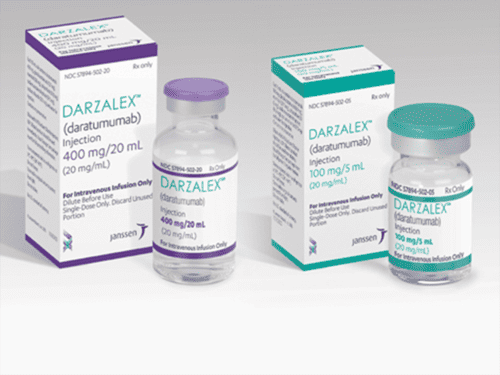
Janssen is looking to broaden the use of its multiple myeloma blockbuster Darzalex, this time combining it with Celgene’s Revlimid and corticosteroid medicine dexamethasone in patients not eligible for transplant.
It has filed the regimen with the EMA just two months after its submission to the FDA, which will quickly assess the Darzalex combination under the Real-Time Oncology Review pilot programme.
The EMA submission is based on data from the phase 3 MAIA study, which evaluated the regimen in multiple myeloma patients ineligible for an autologous stem cell transplant – an operation whereby stem cells are harvested from the bone marrow and then re-infused back into the patient post-treatment.
Those patients were directly compared to a group taking Revlimid and dexamethasone (Rd) alone, and results showed that at a median follow-up of 28 months, the Darzalex regimen significantly reduced the risk of disease progression or death by 44% compared to Rd.
Janssen confirmed that the median progression-free survival for the combination has not yet been reached, compared to 31.9 months in those who received Rd alone.
Nevertheless, researchers identified that the Darzalex combination provided patients with deeper responses compared to Rd alone, including increased rates of complete response (CR) or better (48% vs. 25%) and improved rates of very good partial response (VGPR) or better (79%vs. 53%).
“Today’s submission brings us one step closer to our goal of improving treatment outcomes for people newly diagnosed with multiple myeloma,” said José Antonio Burón Vidal, VP Medical Affairs, Europe, Middle East and Africa (EMEA), Janssen-Cilag Limited.
If approved, the new setting will help Darzalex establish itself as a frontline setting for a range of myeloma treatment settings. Last year it gained US and EU approval for first line use in combination with another existing regimen, Velcade (bortezomib) melphalan and prednisone (VMP) in patients ineligible for autologous stem cell transplant.
The myeloma therapy class is one that it is increasingly competitive, but despite this, Janssen has seen a lot of success with its anti-CD38 antibody since its launch back in 2016. It generated more than $2bn in sales last year, a rise of 63% from 2017, chiefly due to its good toxicity profile and its robust performance when combined with other drugs.
Sanofi also has a promising CD38-targeting antibody for myeloma, which is tied to its own combination programme with Celgene’s Pomalyst/Imnovid (pomalidomide) and low-dose dexamethasone.
The French drug maker claims that its medicine was able to prolong progression-free survival and is seeking approvals as both a first- and second-line treatment.
Additionally, both MorphoSys and Takeda each have their own myeloma drugs in mid-stage testing and Bristol-Myers Squibb and AbbVie are hoping that SLAMF7 targeting Empliciti, in combination with Revlimid, can win some of the market share.
Meanwhile Roche and its marketing partner AbbVie have suffered a setback to another potential multiple myeloma treatment, Venclexta. The drug is approved in CLL, but not yet approved for use in multiple myeloma, however the FDA just issued a warning after a review of its phase 3 BELLINI trial revealed an increase in the risk of death in those taking the treatment compared to the control arm, with the trial placed under a partial clinical hold.




